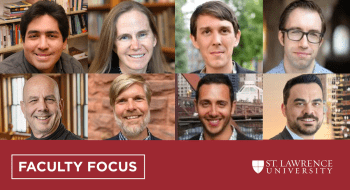
First Person: Mokuhanga, My Printmaking Journey
A fishing boat, small enough to miss, is suspended in the frothy jaws of a monstrous wave, moments away from the water’s crash. Mt. Fuji watches silently from the background, subtle and stable in the midst of this raging ocean scene.
Undoubtedly the most famous work of Japanese printmaking, many are already familiar with Hokusai’s “Under a Wave off Kanagawa,” often known simply as “The Great Wave” (see this blog’s first picture for reference). The image decorates dorm walls, has made its way onto a Pink Floyd drum set, and even inspired the Quiksilver clothing brand logo. I’ve known and admired this print for years, but since landing myself in a Japanese printmaking course here at SLU, the piece has become near and dear to my heart and represents my favorite part of my St. Lawrence career.
To make a short story shorter, I enrolled in a course on mokuhanga without having any prior experience in art, and in a few hours of class time, I was in love with this style of Japanese printmaking. Ultra-clean lines are produced by the cut of a carver’s knife into Japanese shina plywood, and the colors are transferred from the carved blocks to paper via means of a “human printing press:” your own arm becomes the device pressing block to paper, eliminating the need for a heavy, expensive printing press. As our professor always points out, the water-based inks and small list of supplies makes for the perfect at-home art form—it could be done on your kitchen table!
Despite a rewarding final product, it’s the process that gives mokuhanga its charm. Each step requires complete attention, something that is hard to come by on a college campus. As with many students, the whirlwind of academic-social-homesick college-ness hit me early and hard, and by my second semester, I was finding it nearly impossible to bring my focus down to a single thing for longer than a few minutes. But with mokuhanga…hours flew by as I sat by a block of wood, slowly transforming its surface into a piece of a printmaking puzzle. Never had I felt more in the zone. The dual requirement of precision and creativity demanded it all, and my brain was completely fine with this required level of concentration because, simply put, it was fun!
The quiet thrill of a perfect carve is accompanied by the ever-present confidence provided by our printmaking professor, Melissa Schulenberg. She’s a true link to the source, as she’s made several printmaking pilgrimages to Japan and brings us as close to a Tokyo printmaking workshop as one can get in the United States. With tons of connections in the mokuhanga world, a world of experience and accompanying stories, and answers to each of the (many) questions we have about the deceptively tricky process, she holds open the gate to mokuhanga for new students every year. Her artwork can also be seen online here.
I owe a lot to St. Lawrence’s rather flexible curriculum for my discovery of mokuhanga—despite being a religious studies major, my dabbling in some art courses was not only possible but encouraged. From talking to friends, this seems to be a common theme among SLU students. The liberal arts format leads to the discovery of new interests, and frequently this discovery blossoms into a major or minor. In my senior year, I’ve returned to mokuhanga for a ramped-up version of the course I took in my first year, ready to complete my bookend printmaking experience here at St. Lawrence. My first great experience at SLU, and now the highlight of my last semester, mokuhanga will be my fondest memory of St. Lawrence and will find its way to all my future kitchen tables.



